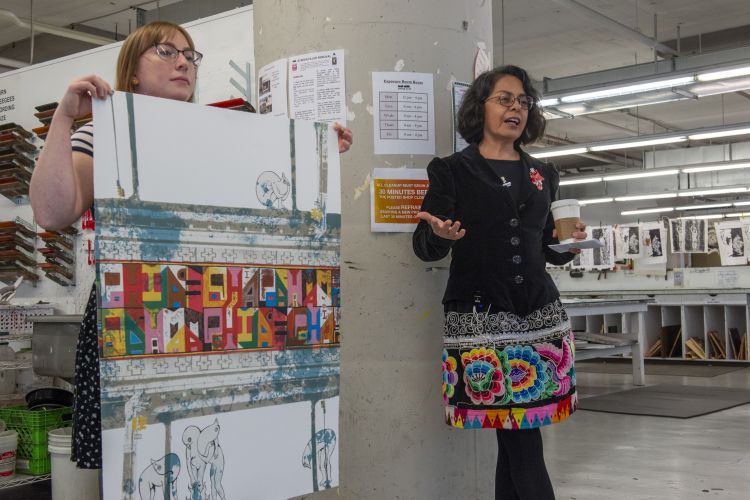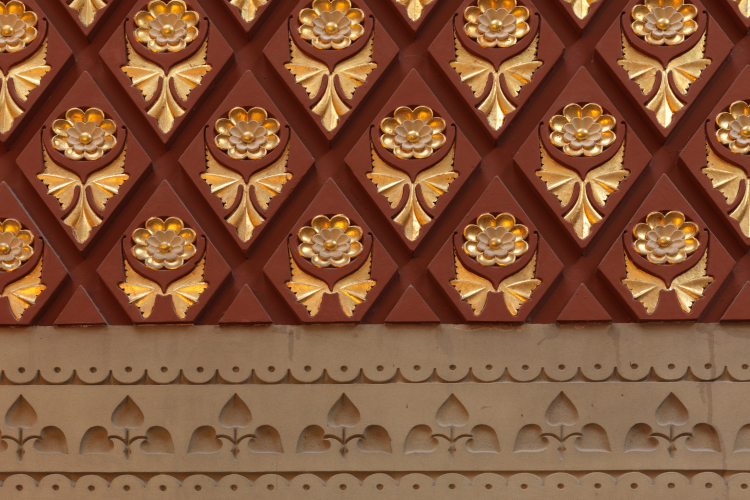STORIES FROM PAFA
Five Influential Figures in PAFA’s Cast Hall
About Cast Hall
Back in the 17th and 18th centuries, European art academies rigorously trained artists with practical lessons on human anatomy and hands-on sessions studying classical sculptures. Upon PAFA’s founding in 1805, Charles Wilson Peale enlisted Nicholas Biddle, secretary to the American ambassador in France and brother of fellow founder William Biddle, to ship casts directly from Paris—crafted by the official cast maker of the Louvre Museum.
Tragically, a devastating fire razed much of the original collection:
“In 1845, the buildings appropriated to the uses of the Academy and occupying the valuable site on Chestnut Street, belonging to stockholders consisted of the large central rotunda; the northern gallery appropriated to pictures; and the eastern gallery, in which was placed the valuable collection of plaster casts, embracing well-preserved models of nearly every chef d' oeuvre of ancient and modern sculpture. Of these buildings, the two galleries were entirely destroyed and the rotunda was greatly injured…of the noble collection of casts, scarcely a vestige remained.”
From the 46th Annual Report for the Pennsylvania Academy of the Fine Arts, 1851. The Pennsylvania Academy of the Fine Arts' Dorothy and Kenneth Woodcock Archives, 1851-AR.pdf.
Despite the fire, PAFA swiftly replenished its cast collection. which by 1889 encompassed 280 pieces ranging from statues to anatomical fragments. In 1987, PAFA received a full-size replica of Michelangelo’s David from John Wanamaker department store. The original source of this cast remains unknown, but it likely originated in Italy. Throughout the early 20th century, museums and galleries worldwide began acquiring and exhibiting casts. Today, PAFA's Cast Hall houses over 120 fine and rare plaster casts, constituting one of the United States' foremost collections, renowned for its exceptional artistry and rarity.
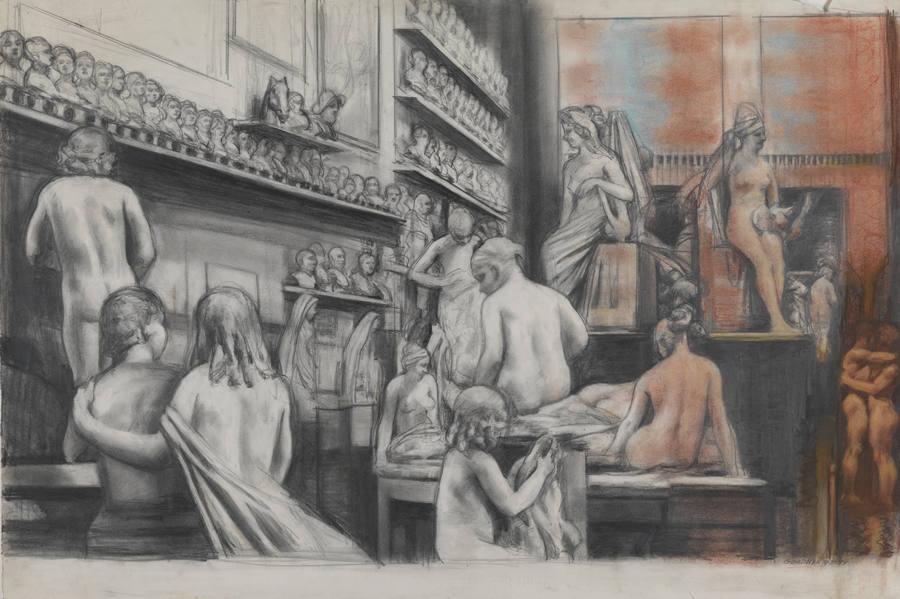 | 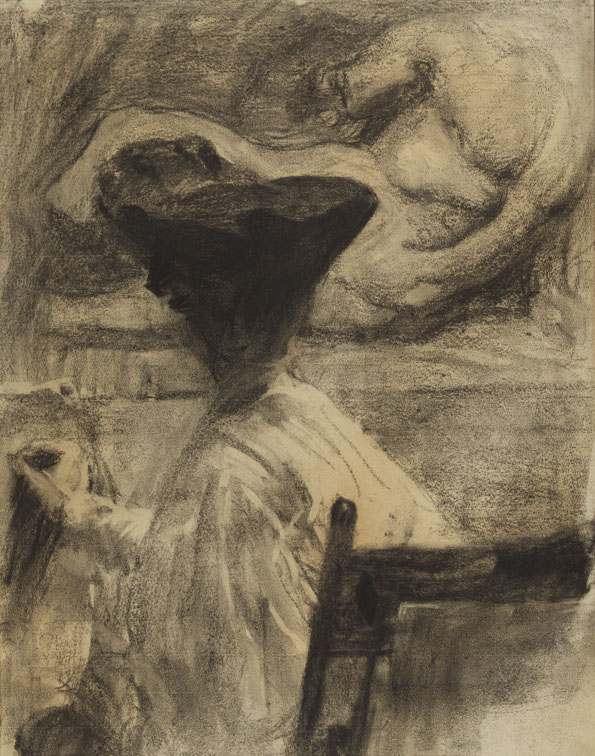 |
(Left) Sidney Goodman, Cast Hall at the Academy, 1993-1994. Charcoal and pastel on paper, 30 x 42 in. (76.2 x 106.68 cm.). Museum Purchase © Estate of Sidney Goodman / Artists Rights Society (ARS), New York, 2012.30.4. Sydney Goodman was a PAFA instructor from 1978-2011; (Right) Thomas Pollock Anshutz, Woman Drawing, ca. 1895. Charcoal on paper, 24 x 18 1/4 in. (60.96 x 46.355 cm.). Gift of Raymond J. and Margaret Horowitz, 2007.13. Thomas Anshutz's incorporated the Cast Collection in his cirriculum.
Cast collections like PAFA's play a crucial role in preserving historical artworks, offering educational opportunities, supporting research, enhancing global accessibility to art, aiding conservation efforts, promoting cultural exchange, and contributing significantly to the preservation and appreciation of artistic heritage—observe these influences firsthand during your next museum visit.
1. Nike of Samothrace, c. 200–190 B.C.E., Louvre Museum
Label: “Original of Parian Marble in the Louvre, Paris / Discovered 1863 Island of Samothrake / Presented by John Stuthers”
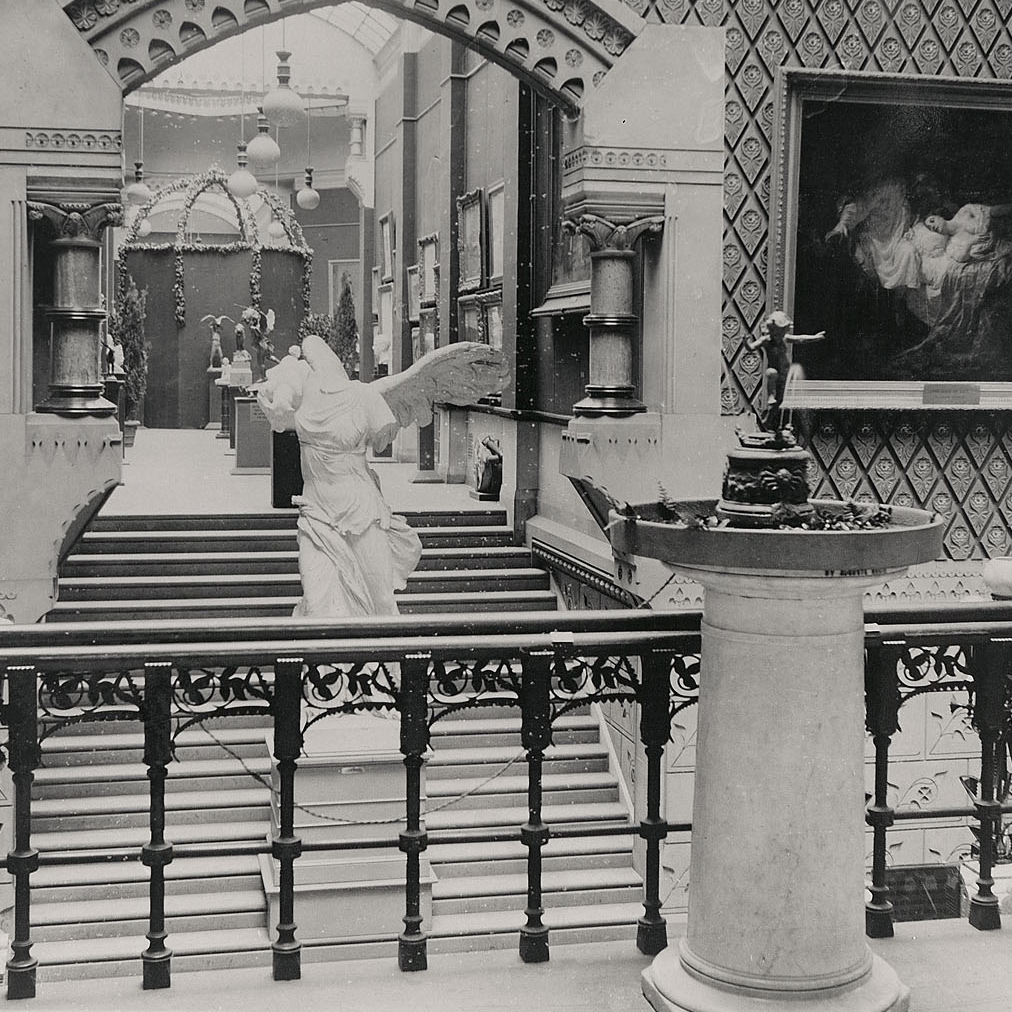 | 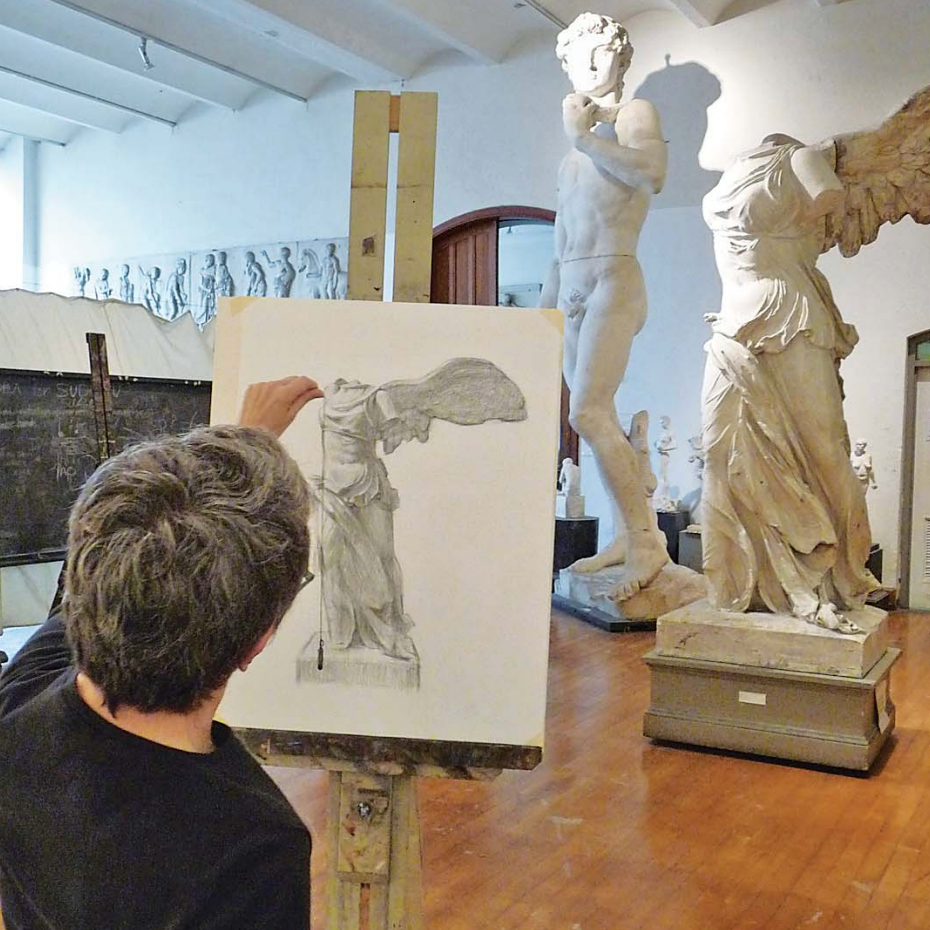 | 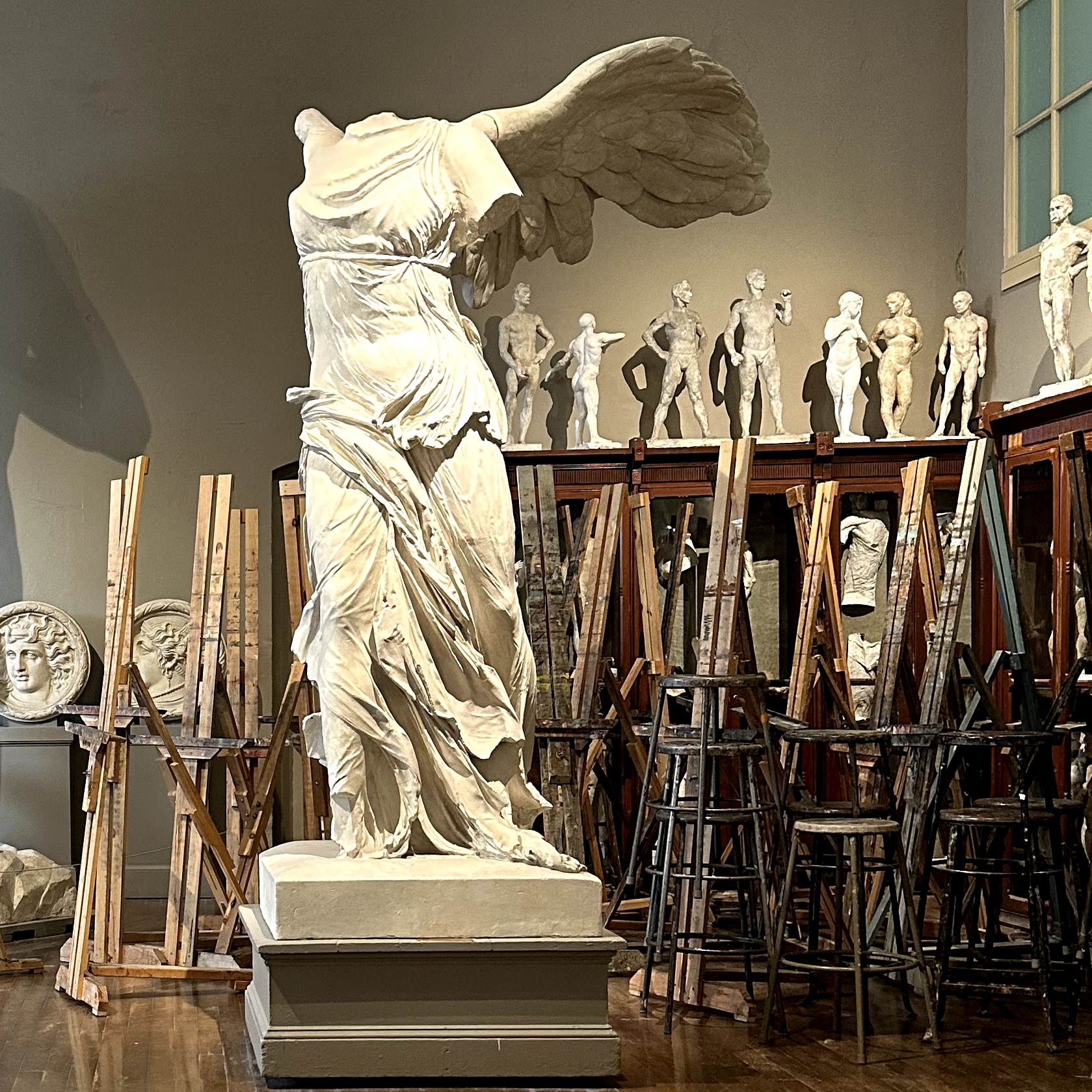 |
(Left) Nike of Samothrace, Installation photograph of the Main Corridor from the east, at the Pennsylvania Academy of the Fine Arts, 1901. The Pennsylvania Academy of the Fine Arts' Dorothy and Kenneth Woodcock Archives, PC0104_1901_002.(Center) A student uses a plumb bob to align her drawing of the cast of the Winged Victory. Photograph by Cheryl Leibold, 2008 (Right) Nike of Samothrace in Cast Hall, 2024. Photo by Kristin Geiger-Rayca.
The Nike of Samothrace, a masterpiece of Hellenistic sculpture dating back to around 200-190 B.C.E., resides in the Louvre Museum. Depicting Nike, the goddess of victory, in dynamic flight, the sculpture is celebrated for its dramatic pose and flowing drapery. It has inspired countless artists across centuries, including Michelangelo and Rodin, who adapted its dynamic composition and emotional intensity in their own works. Symbolizing triumph and heroism, the Nike of Samothrace continues to captivate viewers with its timeless beauty and narrative power.
Learn More:
- Dr. Amanda Herring, "Nike (Winged Victory) of Samothrace," in Smarthistory, August 11, 2021, accessed May 22, 2024.
- The Daru staircase at the Louvre
- Winged Victory: the Nike of Samothrace, World History Encyclopedia
2. Andrea del Verrocchio, David with the Head of Goliath
 | 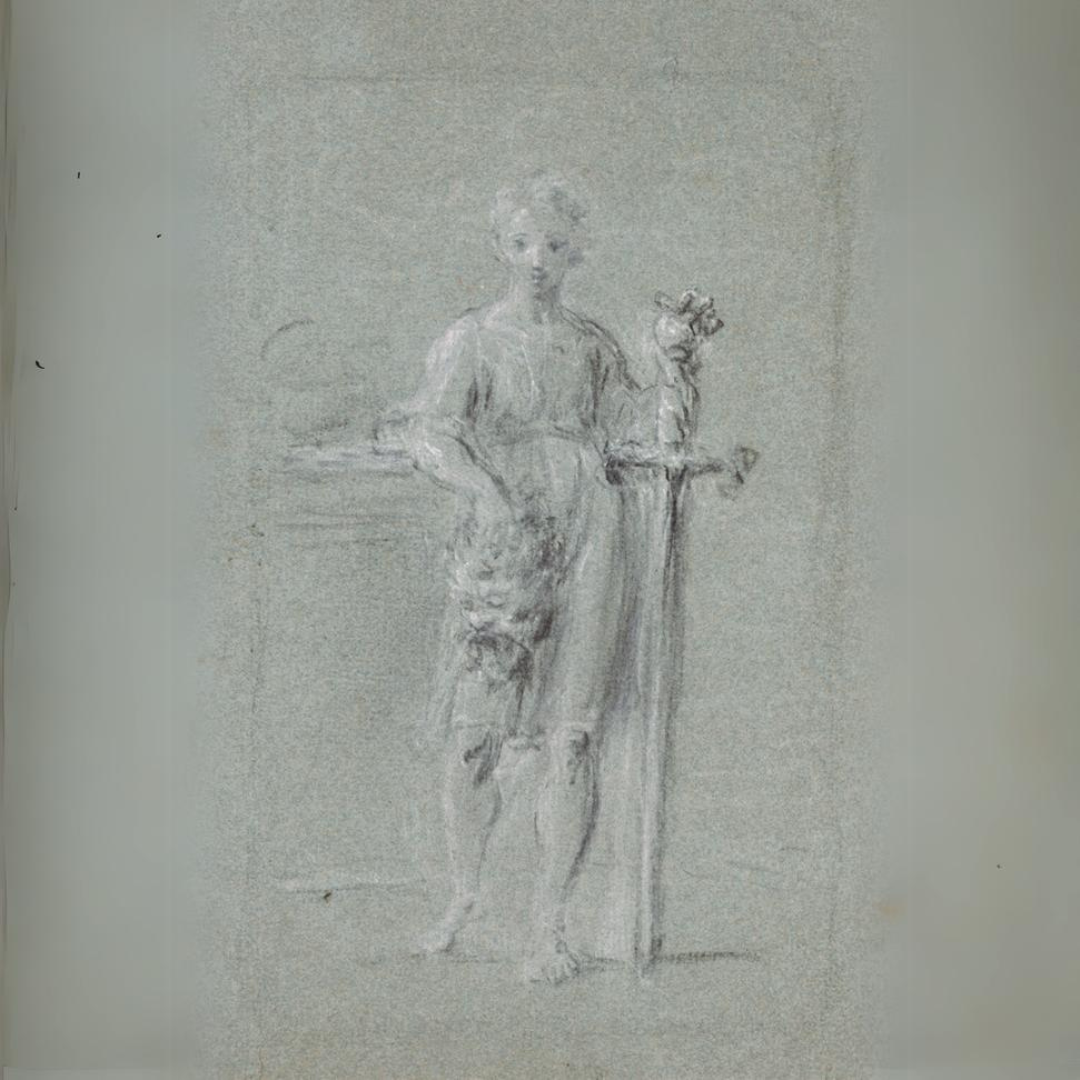 | 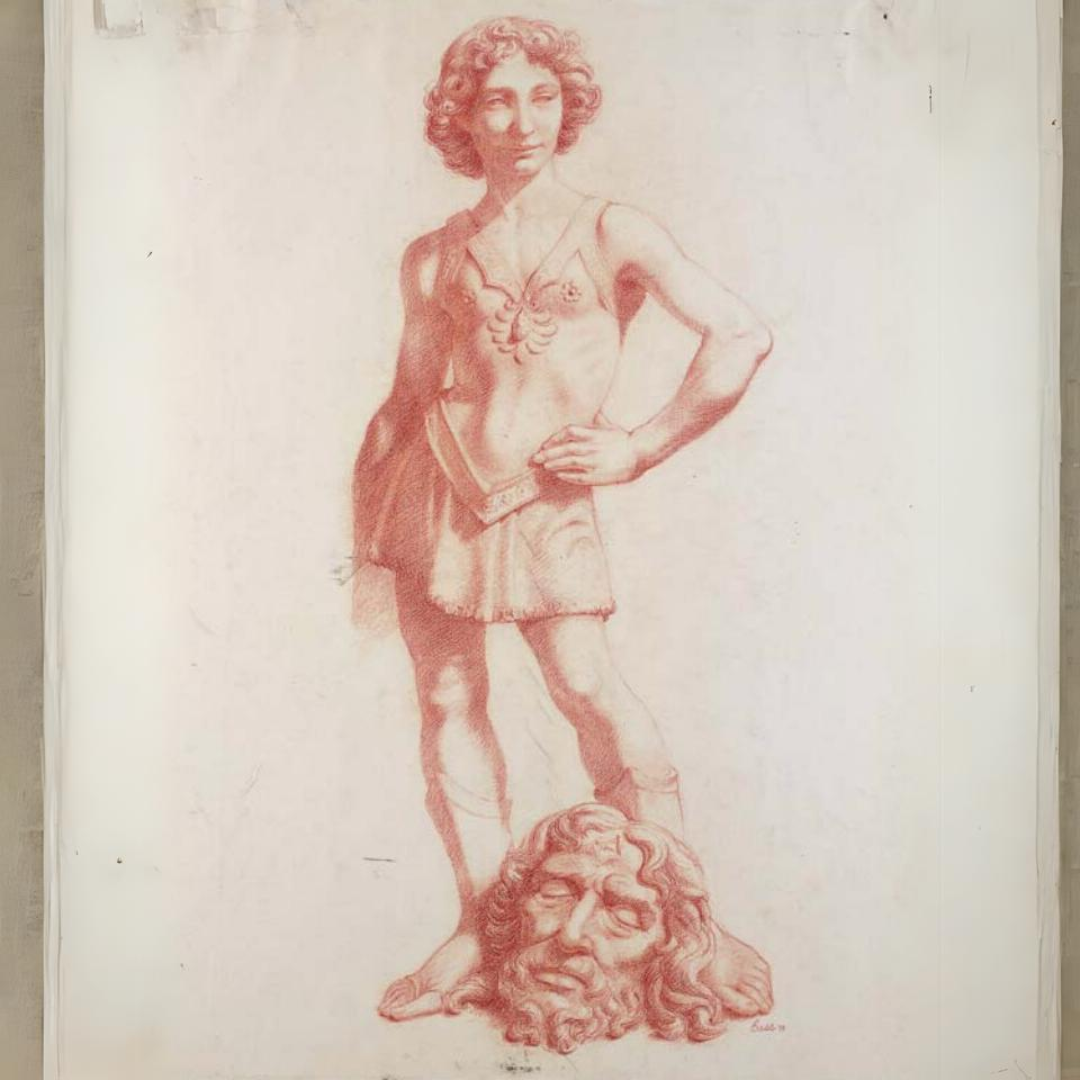 |
(Left) 'David with the Head of Goliath,' 2024. Photo by Kristin Geiger-Rayca (Center) [David with the head of Goliath], Attributed to Benjamin West, late 18th century. Charcoal drawing heightened with gray/ white chalk on blue laid paper, 9 3/8 x 6 3/8 in. (23.8125 x 16.1925 cm.). Gift of George W. Childs, 1885.4.6. (Right) Lyndall Bass (b. 1952), drawing of a cast of Verrocchio’s David, ca. 1972. Sanguine, 24 x 18 inches. PAFA school collection.
Crafted around 1465, Andrea del Verrocchio's David with the Head of Goliath exemplifies Renaissance sculpture. Commissioned by the Medici family and installed at Palazzo Vecchio, Florence, this sculpture captures David in a moment of contemplation after his victory over Goliath. Verrocchio's mastery of realism and narrative storytelling influenced his pupils, including Leonardo da Vinci, who absorbed Verrocchio's teachings on perspective and anatomy, shaping his own revolutionary contributions to art. The sculpture stands as a symbol of Florence's resilience and artistic innovation during the Renaissance.
Learn More:
- Dr. Beth Harris and Dr. Steven Zucker, "Verrocchio, David with the Head of Goliath," in Smarthistory, September 6, 2022, accessed May 21, 2024.
- "Verrocchio: Sculptor and Painter of Renaissance Florence," National Gallery of Art.
3. Bust of Ariadne
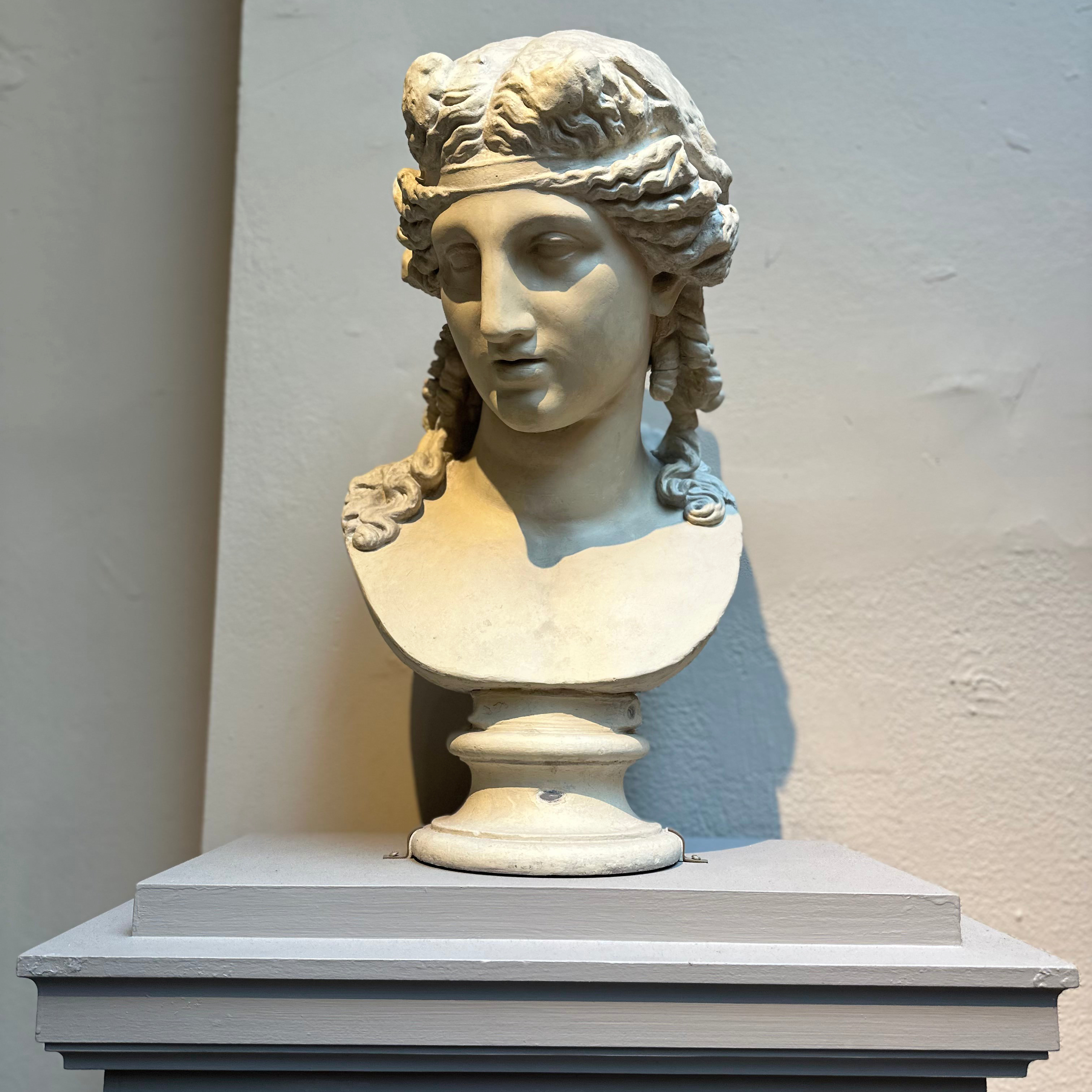 | 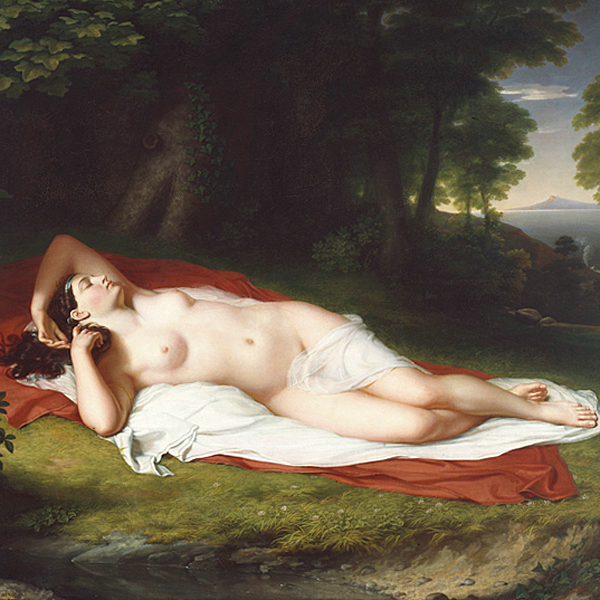 | 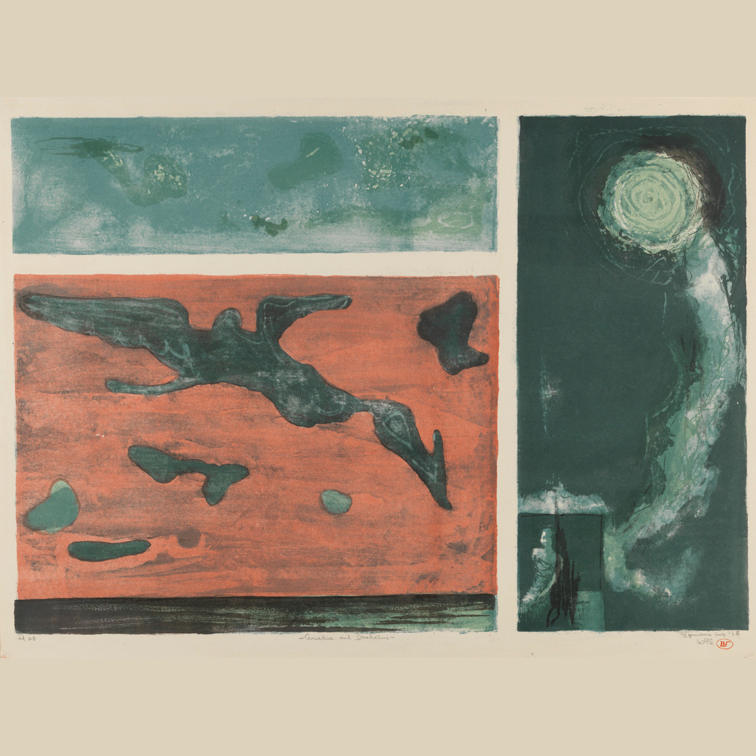 |
(Left) Bust of Ariadne in Cast Hall, 2024. Photo by Kristin Geiger-Rayca (Center) John Vanderlyn, "Ariadne Asleep on the Island of Naxos," 1809-1814. Oil on canvas, 68 1/2 x 87 in. (173.99 x 220.98 cm.). The Pennsylvania Academy of the Fine Arts, Gift of Mrs. Sarah Harrison (The Joseph Harrison, Jr. Collection), 1878.1.11. (Right) Benton Murdoch Spruance, "Ariadne and Daedalus," 1965. Four color lithograph on cream wove paper, 19 1/4 x 27 1/2 in. irr. (48.895 x 69.85 cm.). Gift of Mrs. Benton Murdoch Spruance © artist or artist’s estate, 1975.5.46.
The Bust of Ariadne, despite its unknown sculptor and exact date, holds significant influence due to its connection to Greek mythology and the enduring popularity of Ariadne's story. Ariadne, the daughter of King Minos and Queen Pasiphae, aided Theseus in slaying the Minotaur by providing him with a thread to navigate the labyrinth beneath the palace of Knossos. After Theseus's victory, he abandoned Ariadne on Naxos, where she later married Dionysus. In visual art, Ariadne appears in various mediums, such as John Vanderlyn's painting "Ariadne Asleep on the Island of Naxos,” capturing the emotional moment when Ariadne discovers Theseus's abandonment, contrasting his heroic triumph with her personal tragedy. Depicted in ancient Roman and Greek mosaics and frescoes, Ariadne's mythological influence extends to literature, theater, opera, and dance, exploring themes of love, betrayal, and resilience.
Learn More:
4. Venus de Medici
 | 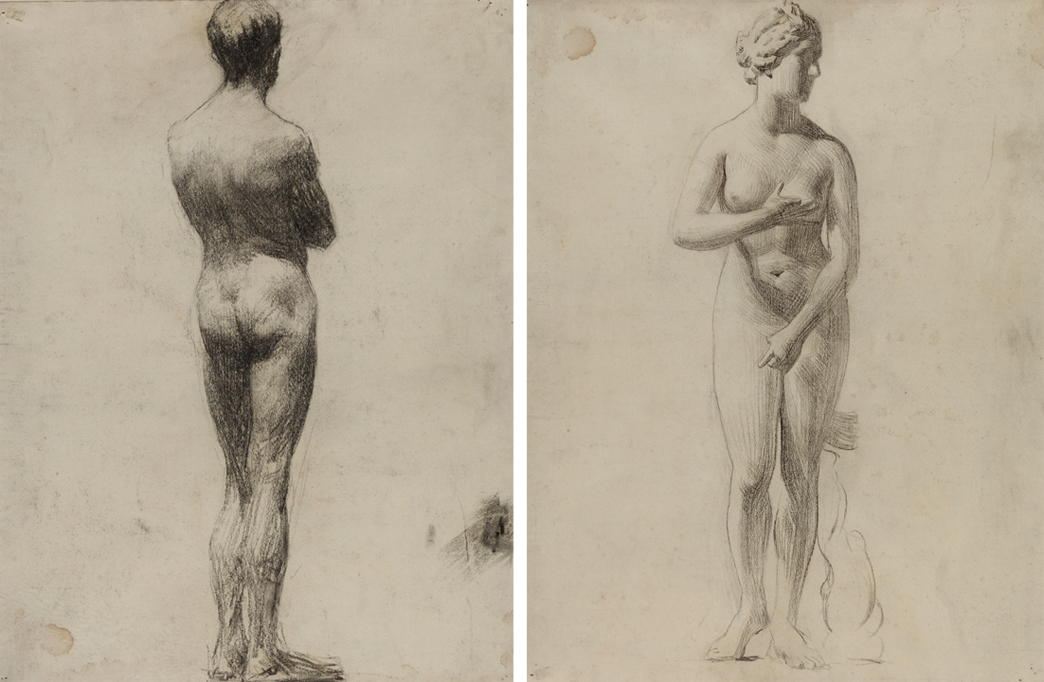 |
(Left) Venus de Medici in Cast Hall, 2024. Photo by Kristin Geiger-Rayca. (Right) Thomas Pollock Anshutz,[Figure study: male standing, back view] recto; [Cast drawing: Venus, front view] verso, 1850-1912. Charcoal on white laid paper, 24 1/4 x 18 1/2 in. (61.595 x 46.99 cm.). Gift of Mrs. Edward R. Anshutz, 1971.8.76a&b.
Dating back to the 1st century B.C.E., the Venus de Medici is a renowned example of Hellenistic sculpture. Displayed in the Uffizi Gallery, Florence, this sculpture portrays Aphrodite, the goddess of love, in a graceful contrapposto pose. Its idealized beauty and classical proportions have influenced generations of artists, from neoclassical sculptors like Antonio Canova to modern interpretations by artists such as Auguste Rodin and Jeff Koons. The Venus de Medici remains an icon of feminine beauty and desire, embodying the timeless ideals of classical artistry.
Learn More:
5. Laocoön
 | 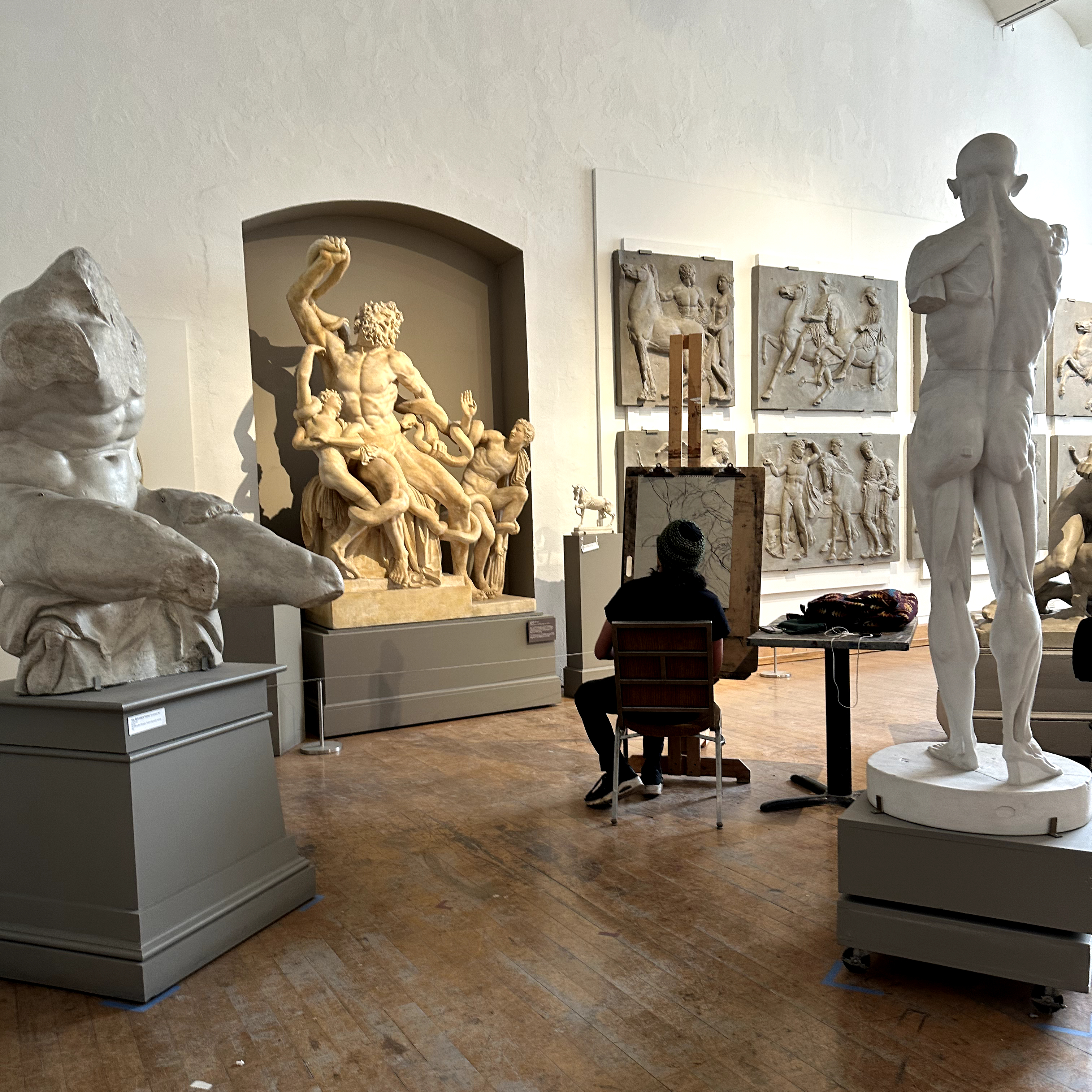 | 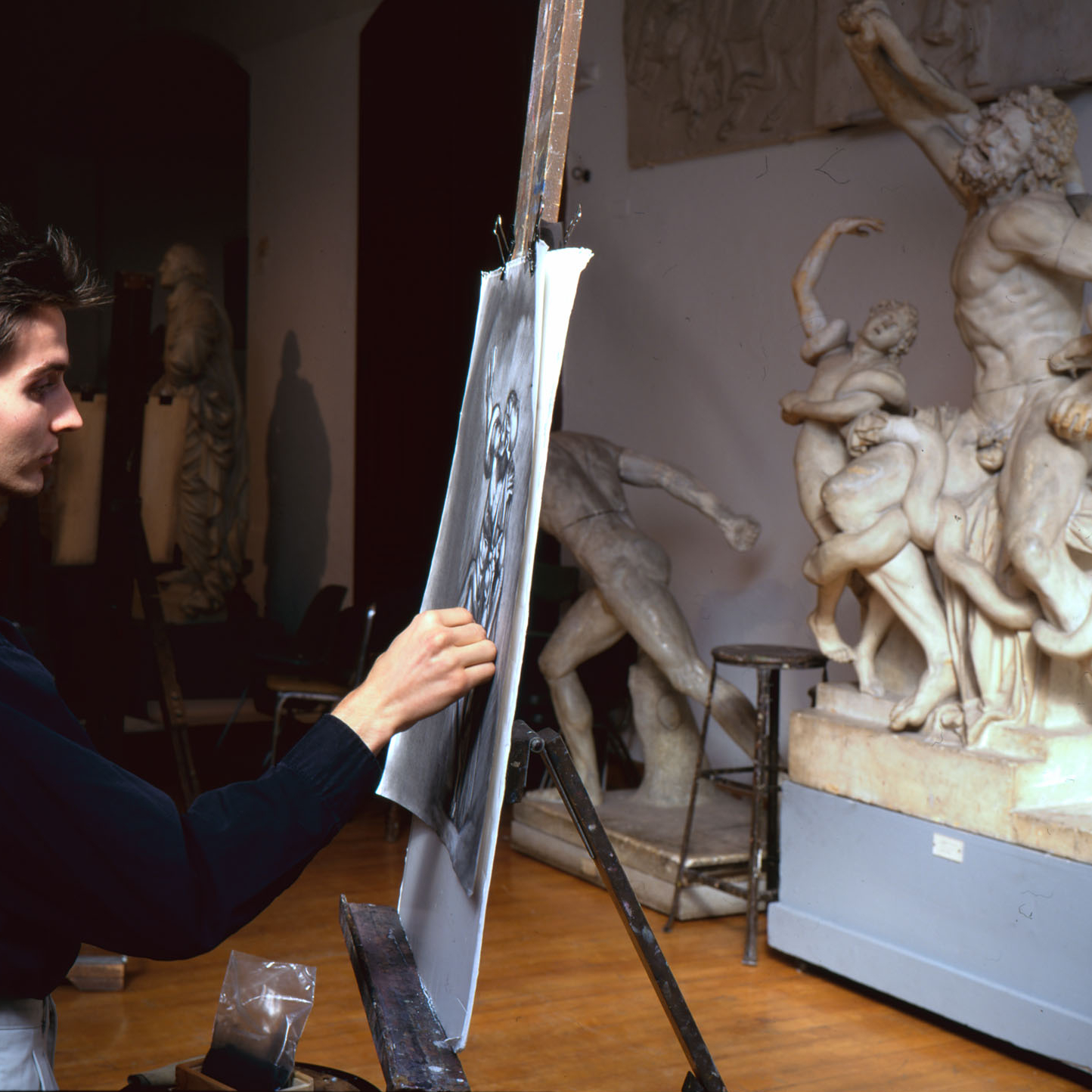 |
(Left) Photo of Laocoön in Cast Hall, 2024 ; (Center) PAFA student in Cast Hall sketching Laocoön, 2024; (Right) Color transparency of cast drawing class, circa 2000-2001. Pennsylvania Academy of the Fine Arts, Archives, PC01100988.
The Laocoön, an ancient Greek sculpture discovered in 1506, depicts a dramatic scene from Greek mythology. Created around the 1st century B.C.E., it portrays the priest Laocoön and his sons struggling against sea-serpents sent by the gods. Known for its emotional intensity and narrative complexity, Laocoön influenced art such as Benjamin West’s "Death on the Pale Horse,” in which the father figure bears a resemblance to Laocoön. Michelangelo, who was present when this sculpture was rediscovered, entered a contest to restore it’s missing arm but lost to Jacopo Sansovino. In the Last Judgment fresco in the Sistine Chapel, Michelangelo depicted Jesus’ arm in the same manner he drew Laocoön’s arm for the contest.
In 2015, PAFA loaned this cast to the Philadelphia Museum of Art for an exhibition titled "The Wrath of the Gods: Masterpieces by Rubens, Michelangelo, and Titian." The process of disassembling and packing the cast was documented in a blog post and captured in a timelapse video.
Learn More:
